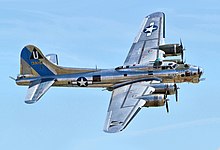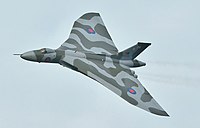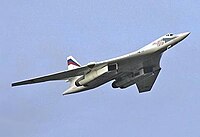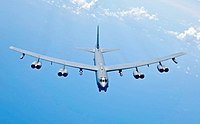Strategic bomber
A strategic bomber is a medium- to long-range penetration bomber aircraft designed to drop large amounts of air-to-ground weaponry onto a distant target for the purposes of debilitating the enemy's capacity to wage war. Unlike tactical bombers, penetrators, fighter-bombers, and attack aircraft, which are used in air interdiction operations to attack enemy combatants and military equipment, strategic bombers are designed to fly into enemy territory to destroy strategic targets (e.g., infrastructure, logistics, military installations, factories, etc.). In addition to strategic bombing, strategic bombers can be used for tactical missions. There are currently only three countries that operate strategic bombers: the United States, Russia[1] and China.
The modern strategic bomber role appeared after
.History
First and Second World Wars
The
Study of strategic bombing continued in the interwar years. Many books and articles predicted a fearful prospect for any future war, paced by political fears such as those expressed by British Prime Minister Stanley Baldwin who told the House of Commons early in the 1930s that "the bomber will always get through" no matter what defensive systems were undertaken. It was widely believed by the late 1930s that strategic "terror" bombing of cities in any war would quickly result in devastating losses and might decide a conflict in a matter of days or weeks. But theory far exceeded what most air forces could actually put into the air. Germany focused on short-range tactical bombers. Britain's Royal Air Force began developing four-engine long-range bombers only in the late 1930s. The U.S. Army Air Corps (Army Air Forces as of mid-1941) was severely limited by small budgets in the late 1930s, and only barely saved the B-17 bomber that would soon be vital. The equally important B-24 first flew in 1939. Both aircraft would constitute the bulk of the bomber force for USAAF strategic bombing in Europe and Allied day bomber units more generally.
At the start of
Following the untimely death of the top German advocate for strategic bombing, General
By the end of the Second World War in 1945, the "heavy" bomber, epitomized by the British
The Cold War and its aftermath
During the
The British produced three different "V bombers" for the Royal Air Force which were designed and designated to be able to deliver British-made nuclear bombs to targets in European Russia. These bombers would have been able to reach and destroy cities such as Kiev or Moscow before American strategic bombers. While they were never used against the Soviet Union or its allies, two V bomber types, the Avro Vulcan and the Handley Page Victor, were used in the Falklands War towards the end of their operational lives.
The Soviet Union produced hundreds of unlicensed copies of the American Boeing B-29 Superfortress, which the Soviet Air Forces called the Tupolev Tu-4. The Soviets later developed the jet-powered Tupolev Tu-16 "Badger".
The People's Republic of China produced a version of
During the 1960s France produced its
The French Republic limited its strategic armaments to a squadron of four

Newer strategic bombers such as the Rockwell B-1 Lancer, the Tupolev Tu-160, and the Northrop Grumman B-2 Spirit designs incorporate various levels of stealth technology in an effort to avoid detection, especially by radar networks. Despite these advances earlier strategic bombers, for example the B-52 last manufactured in 1962 and the Tupolev Tu-95, remain in service and can also deploy the latest air-launched cruise missiles and other "stand-off" or precision guided weapons such as the JASSM and the JDAM.
The Russian Air Force's new Tu-160M2 strategic bombers are expected to be delivered on a regular basis over the course of 10 to 20 years[when?]. The Tu-95 and Tu-160 bombers will be periodically updated, as was done during the 1990s with the Tu-22M bombers.
Strategic bombers of the
Notable strategic bombers
Nomenclature
Bombers listed below were used in the main or represented a shift in long-range bomber design (Maximum bomb load). In practice, bomb loads carried are dependent on factors such as the distance to target and the individual type, size or weight of bombs used.
Nomenclature for size classification of aircraft types used in strategic bombing varies, particularly since the time of World War II due to sequential technological advancements and changes in aerial warfare strategy and tactics. The B-29, for example was a benchmark aircraft of the heavy bomber type at end of World War II due to its size, range and load carrying ability; as the Cold War began, it became an intercontinental range strategic bomber with the development of new techniques, such as aerial refueling (which also greatly extended the range of other medium- to long-range bombers, fighter-bombers and attack aircraft).
During the 1950s the U.S. Strategic Air Command also briefly brought back the outdated term "medium bomber" to distinguish its Boeing B-47 Stratojets from somewhat larger contemporary Boeing B-52 Stratofortress "heavy bombers" in bombardment wings; older B-29 and B-50 heavy bombers were also redesignated as "medium" during this period.[2][3][4] SAC's nomenclature here was purely semantic and bureaucratic, however as both the B-47 and B-52 strategic bombers were much larger and had far greater performance and load-carrying ability than any of the World War II-era heavy or medium bombers.
Other aircraft such as the twin-jet US FB-111, Douglas A-3 Skywarrior and France's Dassault Mirage IV had nominal warloads of less than 20,000 lb (9,100 kg), and were significantly smaller in size and gross weight compared with their strategic bomber contemporaries, based on which they might be classified as medium bombers. In the nuclear strike role, France would replace its Mirage IVs beginning in the late 1980s with the even smaller, single-engine Mirage 2000N fighter-bomber, a further example of advancing technologies and changing tactics in military aviation and aircraft design. France's newer twin-engine Dassault Rafale multirole fighter also has nuclear strike capability.
World War I
- Caproni Ca.1
- Caproni Ca.3 (1,700 lb (770 kg))
- Gotha G.IV (1,100 lb (500 kg))
- Zeppelin Staaken R.VI(4,400 lb (2,000 kg))
- Zeppelin (about 5,000 lb (2,300 kg))
- Handley Page Type O (2,000 lb (910 kg))
- Handley Page V/1500 (7,500 lb (3,400 kg))
- Sikorsky Ilya Muromets (1,100 lb (500 kg))

Interwar/World War II
- Boeing YB-9 (prototype strategic bomber, inspiration for the B-17)
- Martin B-10 (successors B-17 and B-24 therefore and theoretically the first strategic bomber of the USAAF at that time despite being a medium bomber.)
- Boeing B-17 Flying Fortress (8,000 lb (3,600 kg)) (theoretical maximum: 17,410 lb (7,900 kg))
- Consolidated B-24 Liberator (8,000 lb (3,600 kg))
- Boeing B-29 Superfortress (20,000 lb (9,100 kg)) (maximum of 44,000 lb (20,000 kg) (2 22,000 lb (10,000 kg) Grand Slams))
- Consolidated B-32 Dominator (20,000 lb (9,100 kg))
- Handley Page Halifax (13,000 lb (5,900 kg))[5]
- Avro Lancaster (22,000 lb (10,000 kg))
- Short Stirling (18,000 lb (8,200 kg))
- Farman F.220 (9,240 lb (4,190 kg))
- Heinkel He 177(15,870 lb (7,200 kg))
- Petlyakov Pe-8 (11,000 lb (5,000 kg))
- Piaggio P.108 (7,700 lb (3,500 kg))
Cold War
Weapons loads can include nuclear-armed missiles as well as aerial bombs

- Reciprocating/Turbine engine
- North American AJ Savage (12,000 lb (5,400 kg))
- Lockheed P-2 Neptune – small number converted as carrier-launched nuclear-armed bombers which would have to ditch/recover at land bases
- Boeing B-50 Superfortress (28,000 lb (13,000 kg))
- Convair B-36 Peacemaker (72,000 lb (33,000 kg))
- Tupolev Tu-4 – reverse-engineered version of B-29 Superfortress
- Tupolev Tu-95 (55,000 lb (25,000 kg))
- Avro Lincoln (22,000 lb (10,000 kg))
- Jet engine
- North American B-45 Tornado (22,000 lb (10,000 kg))
- Boeing B-47 Stratojet (25,000 lb (11,000 kg))
- Douglas A-3 Skywarrior – nuclear-armed, carrier-based
- Boeing B-52 Stratofortress (70,000 lb (32,000 kg))
- Myasishchev M-4 (52,910 lb (24,000 kg))
- Tupolev Tu-16 (20,000 lb (9,100 kg))
- Vickers Valiant (21,000 lb (9,500 kg))
- Avro Vulcan (21,000 lb (9,500 kg))
- Handley Page Victor (35,000 lb (16,000 kg))
- Xian H-6(20,000 lb (9,100 kg))
- Supersonic

Russian Air Force Tupolev Tu-160 - Convair B-58 Hustler (19,450 lb (8,820 kg))
- General Dynamics FB-111A – strategic bomber version of the F-111 swing wing strike aircraft
- North American A-5 Vigilante – nuclear-armed, carrier-based (only deployed for a brief period in strategic nuclear strike role for which it was originally designed before transitioning to reconnaissance role)
- Rockwell B-1 Lancer (75,000 lb (34,000 kg) – use of external hardpoints restricted by START I)
- Dassault Mirage IV (16,000 lb (7,300 kg))
- Tupolev Tu-22M Backfire (46,300 lb (21,000 kg))
- Tupolev Tu-160 Blackjack (88,200 lb (40,000 kg))
- Tupolev Tu-22 Blinder (20,000 lb (9,100 kg))
- others designed and built which did not enter operational service:
- North American XB-70 Valkyrie
- Myasishchev M-50 Bounder
- Sukhoi T-4 Sotka
- BAC TSR-2

Post Cold War
- Boeing B-52 Stratofortress (70,000 lb (32,000 kg))
- Northrop Grumman B-2 Spirit (40,000 lb (18,000 kg))
- Rockwell B-1 Lancer (75,000 lb (34,000 kg))
- Tupolev Tu-22M (46,300 lb (21,000 kg))
- Tupolev Tu-95 (55,000 lb (25,000 kg))
- Tupolev Tu-160 (88,200 lb (40,000 kg))
- Xian H-6(20,000 lb (9,100 kg))
Future
- Xian H-20. An under-development stealth bomber by China. Planned to be deployed in 2025.
- Northrop Grumman B-21 Raider. An under-development stealth bomber by the United States, with a goal of supplanting the current Rockwell B-1 Lancer and Northrop Grumman B-2 Spirit.
- Tupolev PAK DA. An under-development stealth bomber by Russia, with a goal of supplanting a portion or all of the current Tupolev Tu-95. Planned to be deployed in 2027.
See also
- Carpet bombing
- High level bombing
- Long Range Strike Bomber program
- Next-Generation Bomber
References
- ISBN 0-8047-5017-3
- ^ "Factsheets : Boeing RB-47H Stratojet". 12 November 2014. Archived from the original on 12 November 2014. Retrieved 31 March 2018.
{{cite web}}: CS1 maint: bot: original URL status unknown (link) - ^ "Eighth Air Force History: U.S. Air Force Fact Sheet". af.mil. Archived from the original on 21 February 2013. Retrieved 31 March 2018.
- ^ Strategic-Air-Command.com, 509th Composite Group, 509th Bombardment Wing
- ^ for the Mark III
- Brown, Michael E. Flying Blind: The Politics of the U.S. Strategic Bomber Program. Ithaca, NY: Cornell University Press, 1992.
- Cross, Robin. The Bombers: The Illustrated Story of Offensive Strategy and Tactics in the Twentieth Century. New York: Macmillan, 1987.
- Green, William. Famous Bombers of the Second World War. New York: Doubleday, 1959, 1960 (two vols).
- Green, William. Warplanes of the Third Reich. New York: Doubleday, 1970.
- Haddow, G. W., and Peter M. Grosz The German Giants: The German R-Planes 1914–1918. London: Putnam, 1969 (2nd ed.)
- Hastings, Max. Bomber Command. New York: Dial Press, 1979
- Jones, Lloyd S. U.S. Bombers 1926 to 1980s. Fallbrook, CA: Aero Publishers, 1980 (3rd ed.)
- Neillands, Robin. The Bomber War: The Allied Offensive Against Nazi Germany. Woodstock, NY: Overlook, 2001.
- Robinson, Douglas H. The Zeppelin in Combat: A History of the German Naval Airship Division, 1912–1918. Atglen, PA: Schiffer, 1994.
- United States Strategic Bombing Survey. Over-all Report (European War). Washington: Government Printing Office, September 30, 1945.

